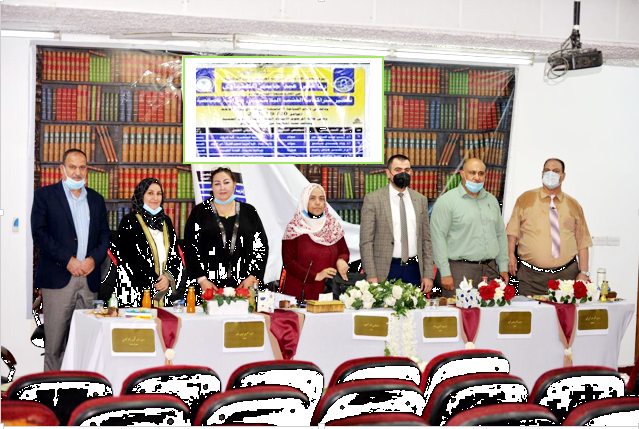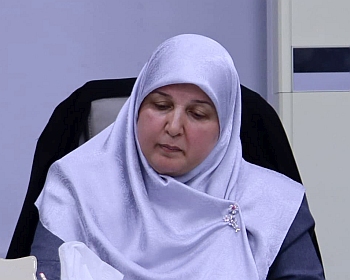ناقش قسم الفيزياء في كلية التربية للعلوم الصرفة ( ابن الهيثم ) أطروحة الدكتوراه الموسومة ( تحضير متراكبات الخشب البلاستيكي ودراسة خصائصه ) للطالبة ( ريا علي عبد جاسم ) التي انجزتها تحت اشراف التدريسي في القسم ( أ.م.د. عبد الحميد رحيم الصراف ) ونوقشت من قبل اعضاء لجنة المناقشة المبينة اسمائهم فيما يأتي :
-
أ.د. زينب عبدالسلام ( رئيسا )
-
أ.د. وداد حمدي ( عضوا )
-
أ.م.د. حسين خزعل ( عضوا )
-
أ.م.د. احمد فاضل حمزة ( عضوا )
-
أ.م.د. محمد عبد النبي ( عضوا )
-
أ.م.د. عبدالحميد الصراف ( عضوا ومشرفا )

واشارت الطالبة في بحثها الى ان ضرورة استغلال المخلفات الزراعية التي قد تؤثر على البيئة من خلال تحضير متراكبات الخشب البلاستيكي باستخدام القصب والتي تدخل في تطبيقات البناء كالمباني والمسطحات المائية والسقوف الثانوية والتي تكون مقاومة للصدمات وذات قوة متانة عالية تفوق الخشب الطبيعي.
وتم في في هذه الدراسة استغلال مخلفات الخشب والاستفادة منها عن طريق تحضير نوعين من متراكبات الخشب البلاستيكي احدهما يتكون من بوليمرات متصلدة بالحرارة ( thermoset) نوع راتنج الايبوكسي, والأخر يتكون من بوليمرات (thermoplastic) نوع بولي بروبلين, حيث تم تحضير متراكبات الايبوكسي المدعم بدقائق الخشب (القصب) بطريقة (casting method) وبكسور وزنية % (0,20,30,40,50) وبثلاث احجام دقائقية mesh (60,150,212) تم الحصول على العديد من العينات, اما النوع الثاني فقد تم تحضير متراكبات البولي بروبلين المدعم بدقائق الخشب (القصب) بطريقة (extrusion molding) وبكسر وزني ثابت لكل العينات % (30) وحجم دقائقي mesh(212) ونتيجة لصعوبة الترابط بين المادة الأساس (البولي بروبلين) ومادة التقوية (دقائق الخشب\القصب) نتيجة اختلاف القطبية بين المادتين تم معاملة دقائق الخشب بالمادة الرابطة السيلانية نوع (ثنائي مثيل ثنائي كلورسيلان) بنسب وزنية مختلفة (0,0.2,0.3,0.5) أيضا تم اضافة مواد تحسن النوعية منها (أوكسيد المغنيسيوم ) كمضادات اكسدة بنسب وزنية (0.1,0.2,0.4( وستيرات الزنك كمزلقات بنسب وزنية (0.1,0.2,0.3), تم الحصول على كل من (P.P+W), (P.P+W+Silane), (P.P+W+MgO), (P.P+W+Zn(C18H35O2)2)
بعد اجراء عمليات التقطيع بجهاز CNC وحسب الفحوصات ASTM , تم اجراء بعض الاختبارات الميكانيكية والفيزيائية والحرارية والتي شملت كل من (الصلادة السطحية, معدل البلى , مقاومة الصدمة, اختبار الانحناء, معدل الزحف , اختبار الشد,اختبار الامتصاصية, الكثافة الحجمية , التوصيلية الحرارية) أظهرت النتائج التي حصلنا عليها ان معدل الصلادة السطحية ومقاومة الصدمة ازداد بشكل واضح بعد التدعيم بدقائق الخشب مع زيادة الكسر الوزني حيث تراوحت بين shore D(41-61) و KJ / m2 (8.76-23.7) للصلابة ومقاومة الصدمة على التوالي اما معدل البلى فقد قل بشكل ملحوظ مع زيادة الكسر الوزني وزاد كل من معدل الصلادة ومقاومة الصدمة مع نقصان الحجم الدقائقي واعلى قيمة كانت عند الحجم mesh 212 واقل قيمة كانت عند الحجم الدقائقي mesh 60 أي كلما كان الحجم الدقائقي صغير كان ذلك افضل ,اما معدل البلى قل بشكل واضح مع زيادة الكسر الوزني , بشكل عام تحسن الاختبارات الميكانيكية بشكل واضح .
اما تأثير إضافة كل من ( المادة السيلانية ,اوكسيد المغنيسيوم ,ستيرات الزنك) على الخصائص المذكورة لمتراكبات البولي بروبلين المدعم بدقائق الخشب فقد أظهرت زيادة الصلادة السطحية ومقاومة الصدمة ومقاومة الشد ومعامل المرونة والتوصيلية الحرارية والكثافة الحجمية التي تم قياسها نظريا حيث كانت أعلى قيم لهذه الاختبارات حوالي (shore D 76 ، 55.88 KJ / m2 ، 28.29 MPa ، GPa0.9 ،W/m.k 0.39 ، g/cm3 0.25 ) على التوالي من ناحية أخرى نقصان معدل البلى مع إضافتها اما معدل الامتصاصية فقد أظهرت استجابة واضحة عند الغمر بالماء المقطر ولكن عند الغمر بالمحلول الكيميائي فقد قلت الاستجابة وقلت نسبة الربح بالوزن, اثبتت النتائج بان الخصائص الميكانيكية والفيزيائية والحرارية لمتراكبات (البولي بروبلين- دقائق الخشب) افضل من متراكبات (الايبوكسي-دقائق الخشب ) واعلى معدلات التي توصلنا اليها هي لمتراكب (P.P+W+Zn(C18H35O2)2). من هذا نستنتج بان الخشب البلاستيكي أفضل من الخشب الطبيعي من حيث المتانة والصلابة والقوة والذي يعتبر مقاوم للظروف الجوية والرطوبة.
لطالبة الى التوصيات الاتية :
-
دراسة مقاومة الانضغاط وثابت العزل لمتركبات الايبوكسي والبولي بروبلين المقواة بدقائق الخشب (القصب).
-
دراسة تأثير الأحمال المختلفة على معدل البلى لتمركبات البولي بروبلين المقواة بجزيئات الخشب (القصب)
-
دراسة تأثير درجة الحرارة على معدل الزحف للمتركبات البوليمرية
-
دراسة الخواص الميكانيكية والترايبولوجية للمتركبات البوليمرية الهجينة المكونة من (ايبوكسي – بولي بروبيلين) مقواة بدقائق (القصب)
-
قياس الرطوبة والخصائص البيولوجية للمتركبات بإضافة أكسيد الماغنسيوم










